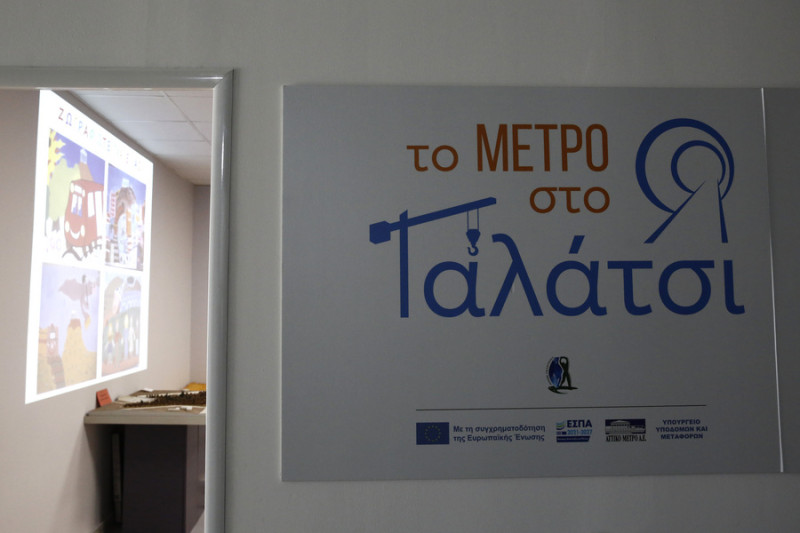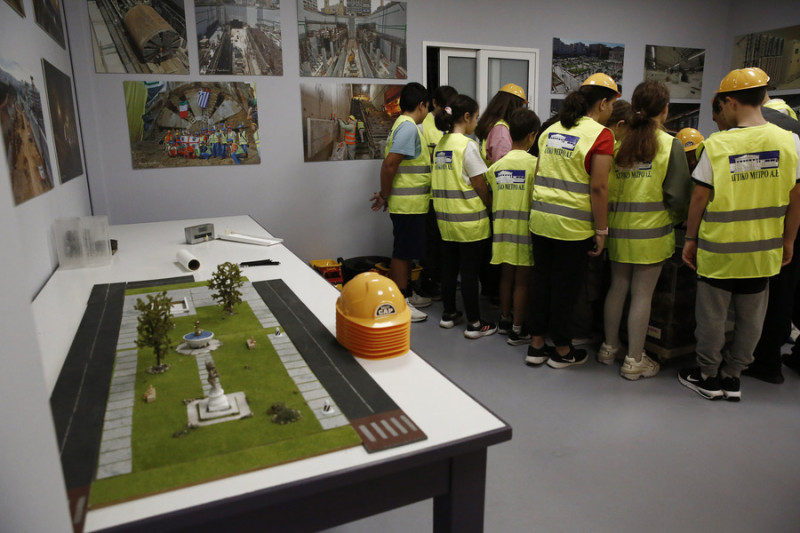Elementary and high school students, through educational interactive activities, learn about the metro and its construction process, choose the correct route of Line 4 in the city of Galatsi
Young students become for a while.. engineers, as they learn the processes of planning, building and operating a subway project in a city, through the innovative educational program “The Metro in Galatsi” implemented by Helliniko Metro S.A., under the auspices of of Galatsi Municipality.
Through the program that is part of the construction of Line 4 (Alsos Veikou-Goudi Section) and takes place in specially designed rooms at the Galatsi Olympic Properties (PALAI), students go through all the construction and operation procedures of the metro , experientially, with the pedagogical term as used ‘Hands On’.
Elementary and high school students, through educational interactive activities, get to know the metro and its construction process, choose the correct layout of Line 4 in the city of Galatsi, which will accommodate three of the 15 total stations of the new line, construct the stations and tunnels and learn how the metro’s electronic systems work. Upon completion of the training program, students receive a commemorative “Engineer” diploma with their name on it.
Mania Benisi, geologist and engineer of Helliniko Metro’s studies department and responsible for the company’s educational programs, spoke to APE-MPE and explains how the idea for this specific program began: “The world of building a metro project in a city, is very fascinating, as from there the ‘guts’ of the city come to the surface, while many specialties are involved that are very different, in terms of perception of things, time perception, social and so on. So from a scientific point of view, I would say that it is ‘challenging’. We felt it was a shame for the children, on their daily walk to and from school, to see a miracle happening right in front of their eyes, outside their school building and not know what it was all about.
Realizing the great enthusiasm of the children for the Metropontics and the modern technology and the traffic technology of the trains of Line 4 (section A), which operate without a driver (driveless), we created a more technical educational program, in which we wanted to involve the children, experientially, i.e. to enter themselves, to construct, to fix, to break, to get in the way, to understand what exactly happens when one goes under the city to build a new technical world.”
Speaking about the program, Ms. Benisi explains: “In the beginning, after watching a very short presentation, the children become transportation engineers and draw themselves on paper in a strategy floor game, different subway lines, where they face obstacles, difficulties or motivations, to go by the specific routes. Then based on pro and con criteria, they decide what is the optimal route and what is the optimal placement of a construction site for the construction of a station, taking into account factual, scientific and technical criteria based on which subway stations are designed. Then the children go into a specially designed room where there is a scale model, where they dig a deep trench in the city itself with simulated soil or rock using their hands with shovels, cranes, trucks.
According to the engineer of Helliniko Metro’s studies department: “The children understand what the difficulties are, what the timescales of the issue are, of removing all these materials within an urban fabric and with safety factors and with appropriate methods , to be able to go deep into the city, and then they build from the bottom to the surface the levels of a station (passenger traffic or the city level), reshape the surface, do architectural work, renovations of public space, squares, transplants trees, placements of works of art, statues, monuments and other symbols.”
As the geologist specifically told APE-MBE, “then they come to a new room where the control and operation systems of a metro line are simulated in an electromechanical panel, that is, they monitor the movement of trains in the various directions from and to a depot, in which they learn what are the basic procedures for parking the trains, for the repairs of the possible damages they may have, for their maintenance, washing and cleanliness, etc. After going through all these specialties, the children feel by themselves that they have become junior engineers, so they also receive a relevant diploma.”
Regarding the importance of the program and what the children get, Mania Benisi emphasizes: “With their imagination, they create new processes, new perspectives, new ways to think about how to utilize the underground space of a city and a very interesting interaction takes place, which has, not only technical and scientific ramifications, but also socio-political ones, because the children experience the work of building the subway in their own city and therefore participating experientially gives them the possibility to all these questions they have, to express them, to discuss them in a lively dialogue and give their own breath to their dreams for the city”, concludes the manager of the program meaningfully.
Source: Skai
I have worked as a journalist for over 10 years, and my work has been featured on many different news websites. I am also an author, and my work has been published in several books. I specialize in opinion writing, and I often write about current events and controversial topics. I am a very well-rounded writer, and I have a lot of experience in different areas of journalism. I am a very hard worker, and I am always willing to put in the extra effort to get the job done.












